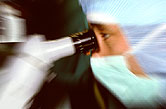Based on single breast slide, overall agreement 75.3 percent for individual pathologist versus consensus
TUESDAY, March 17, 2015 (HealthDay News) — Individual pathologists’ interpretations of a single breast biopsy slide generally concur with expert consensus-derived reference diagnoses, according to a study published in the March 17 issue of the Journal of the American Medical Association.
Joann G. Elmore, M.D., M.P.H., from the University of Washington in Seattle, and colleagues quantified the magnitude of diagnostic disagreement among pathologists compared with a consensus panel reference diagnosis in interpretation of breast biopsies. Participants interpreted slides from test sets of 60 breast biopsies; they were blinded to interpretations of other study pathologists and consensus panel members. Unanimous agreement of independent diagnoses was 75 percent among the three consensus panel members; there was 90.3 percent concordance with consensus-derived reference diagnosis. Data were included from 115 pathologists, providing 6,900 individual case diagnoses.
The researchers found that the overall concordance rate of diagnostic interpretations of participating pathologists was 75.3 percent compared with the consensus-derived reference diagnosis. The overall concordance rate was 87 percent for diagnosis of benign without atypia; 48 percent for atypia; 84 percent for ductal carcinoma in situ; and 96 percent for invasive carcinoma. Among biopsies from women with higher versus lower breast density on prior mammograms, there was significantly higher disagreement with the reference diagnosis (overall concordance rate, 73 and 77 percent, respectively; P < 0.001). Pathologists who interpreted lower weekly case volumes, or worked in smaller practices or nonacademic settings also had higher disagreement with reference diagnosis.
“This study confirms that the majority of diagnoses, especially at either end of the spectrum from benign to invasive cancer, are readily and accurately made by practicing pathologists,” write the authors of an accompanying editorial. “It also identifies areas of uncertainty that must be addressed, providing a framework for process improvement in the pathology and scientific communities, especially in the diagnosis of atypia.”
One author disclosed financial ties to Genentech; assistance for the digital scanning equipment and digital viewer were provided by Ventana Medical Systems and HD View SL.
Abstract
Full Text
Editorial (subscription or payment may be required)
Copyright © 2015 HealthDay. All rights reserved.








